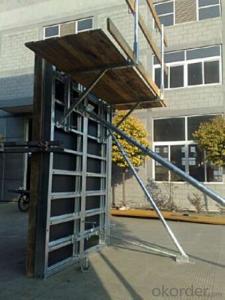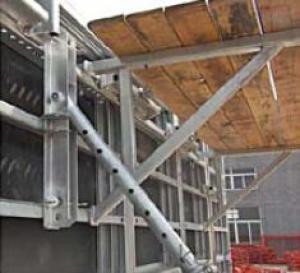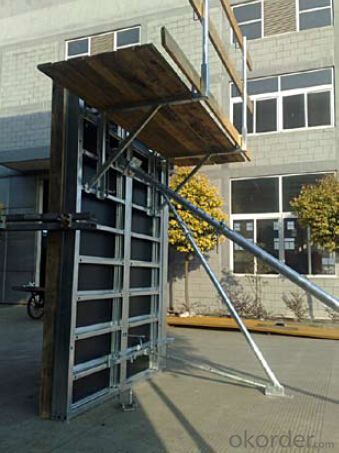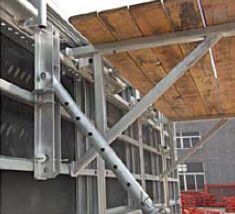Steel Frame working platformfor Formwork and Scaffolding system
- Loading Port:
- Tianjin
- Payment Terms:
- TT OR LC
- Min Order Qty:
- 50 m²
- Supply Capability:
- 1000 m²/month
OKorder Service Pledge
OKorder Financial Service
You Might Also Like
Steel-frame Formwork SF-140
Characteristics:
◆ Few parts for fast forming.
◆ Max. Concrete pressure: 80KN/m2.
◆ Hot-dip galvanized steel frame.
◆ The thickness of plywood is 18mm & the panel is 14cm.
◆ Compatibility with Hunnebeck Manto system due to similar edge profile.
System Details & Application:
◆ Neat joint and fast assembling with aligning panel clamp.
◆ Flexible panel arrangement and height extension.
◆ The selection of panels.
◆ Kinds of panel connectors.
◆ Corner clamp application.
◆ Length adjustment application.
◆ Height adjustment & aligning strut.
◆ Walkway bracket & platform.
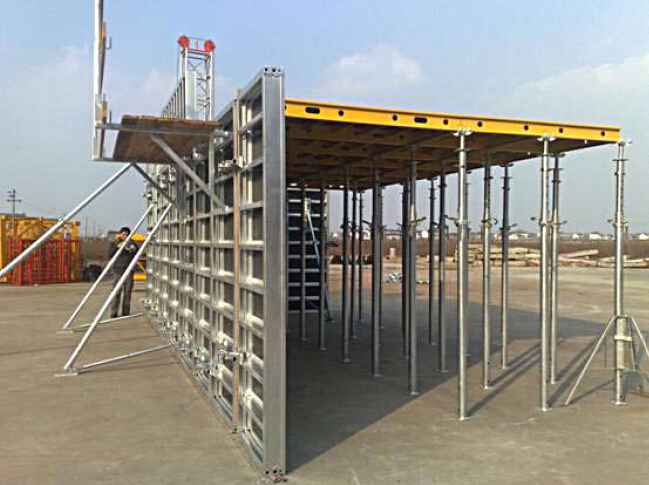
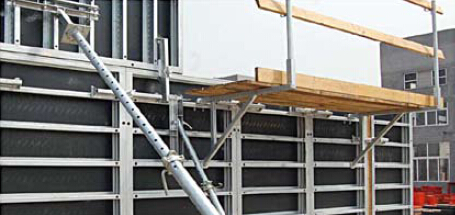
- Q: Can steel formwork be used in corrosive environments?
- Corrosive environments can indeed accommodate the use of steel formwork. Steel is renowned for its durability and strength, making it a suitable option for construction purposes even in corrosive surroundings. However, certain precautions must be taken to ensure its long-term performance. One common precautionary method involves the application of protective coatings such as epoxy or zinc to the steel formwork. These coatings create a barrier that prevents direct contact between the steel and corrosive elements, thereby reducing the risk of corrosion. Another alternative is the utilization of stainless steel formwork, which possesses inherent resistance to corrosion due to its high chromium content. Regular maintenance and inspection are also imperative to promptly detect any signs of corrosion and take appropriate measures to address them. This could entail cleaning the formwork, repairing damaged coatings, or replacing heavily corroded sections. In conclusion, with the proper implementation of protective measures and regular maintenance, steel formwork can effectively withstand corrosive environments and offer a reliable and durable solution for construction projects.
- Q: Can steel formwork be used for underground tunnels?
- Underground tunnels can indeed utilize steel formwork. This material, known for its versatility and durability, is widely employed in various construction endeavors, including underground tunnel projects. Its capacity to withstand the immense pressure and forces from the surrounding soil and rock renders it an ideal choice for tunnel construction. Furthermore, the ease of assembly and disassembly of steel formwork ensures efficient construction and upkeep of tunnels. Given its robustness and resilience, it is no surprise that steel formwork remains a favored option for constructing underground tunnels, guaranteeing a dependable and enduring solution.
- Q: Can steel formwork be used for foundation construction?
- Indeed, foundation construction can make use of steel formwork. Steel formwork proves to be a flexible and long-lasting alternative for the creation of foundations. It affords a solid and steady support system for the pouring of concrete and the achievement of the desired shape and structure of the foundation. Steel formwork presents various advantages, such as its easy assembly and disassembly, reusability, and capacity to withstand substantial loads and pressure. Moreover, steel formwork exhibits high resistance to moisture and can be effortlessly cleaned, rendering it suitable for application in foundation construction projects. All in all, steel formwork stands as a dependable and effective choice for the construction of foundations.
- Q: Are all steel plates used for beam slab prefabrication
- Prefabricated components according to the number of times to determine the turnover, the same specifications of the components to reach more than 10, the general use of stereotypes steel template, the specification of the component is less, the general use of steel or steel formwork formwork
- Q: What are the different types of form ties used in steel formwork systems?
- There are several different types of form ties used in steel formwork systems, each designed to provide a secure connection between the formwork panels and support structures. 1. Conventional Form Ties: These are the most commonly used form ties, consisting of a steel rod with cones or washers on both ends. The rod is inserted through the formwork panels and secured with nuts or wedges, providing a strong connection. 2. Coil Ties: These ties are made from a continuous loop of wire, often galvanized for corrosion resistance. They are easy to install and remove, and can be used for various concrete wall thicknesses by adjusting the length of the loop. 3. She-Bolts: Also known as she-bolts or coil bolts, these form ties consist of a threaded rod embedded in the concrete wall, with a plate and nut on the external side. They provide a solid connection and are commonly used in applications where the formwork needs to be removed and repositioned frequently. 4. Snap Ties: These ties feature a flat plate on one end and a snap-tie wedge on the other. They are quick and easy to install, requiring no special tools. Snap ties provide a reliable connection and are suitable for light to medium-duty applications. 5. Plastic Cone Ties: As the name suggests, these ties are made of plastic and are used with reusable plastic formwork systems. They are lightweight, easy to handle, and offer good resistance to chemical corrosion. 6. Flat Ties: Flat ties are flat strips or bars used to connect the formwork panels. They are typically made of steel and can be easily bent or cut to the desired length. Flat ties are often used in applications where the wall thickness is minimal. 7. Wedge Bolts: These form ties consist of a threaded rod with a wedge-shaped plate and nut. The wedge is inserted into a hole in the formwork panel, and tightening the nut secures the connection. Wedge bolts are commonly used in applications where high strength and quick installation are required. These are just a few examples of the different types of form ties used in steel formwork systems. The choice of form tie depends on factors such as the application, concrete wall thickness, required strength, and ease of installation and removal.
- Q: Is steel formwork suitable for all types of construction projects?
- No, steel formwork may not be suitable for all types of construction projects. It is commonly used in large-scale projects that require repetitive use of formwork, such as high-rise buildings or bridges. However, for smaller or more intricate projects, other types of formwork materials like wood or plastic may be more appropriate. The choice of formwork depends on factors such as project size, complexity, budget, and specific requirements.
- Q: What are the considerations when designing steel formwork for tunnels?
- When designing steel formwork for tunnels, there are several important considerations to take into account. Firstly, the formwork needs to be strong and durable enough to withstand the pressure and forces exerted by the surrounding soil and rock during tunnel construction. It should be able to resist bending, deformation, and potential structural failure. Secondly, the formwork should be designed to be easily assembled and disassembled, as tunnels typically require repetitive formwork installation and removal. It should allow for efficient and quick construction, reducing downtime and costs. Thirdly, the formwork should be designed with proper alignment and accuracy, ensuring that the tunnel's dimensions and shape are precisely maintained. This is crucial for achieving the desired structural integrity and functionality of the tunnel. Additionally, considerations such as corrosion resistance, waterproofing, and fire resistance should be taken into account to ensure the longevity and safety of the formwork. Overall, the design of steel formwork for tunnels needs to prioritize strength, durability, ease of installation, accuracy, and appropriate protective measures to ensure a successful and safe tunnel construction process.
- Q: Are there any specific considerations for using steel formwork in areas with limited space?
- Yes, there are several specific considerations for using steel formwork in areas with limited space. Firstly, the dimensions of the steel formwork system should be carefully chosen to ensure that it can fit into the available space. This includes considering the height, width, and depth of the formwork components, as well as any necessary clearances for movement and installation. Secondly, the assembly and disassembly of the steel formwork system should be carefully planned to minimize the space required. This may involve using smaller formwork panels or modular systems that can be easily transported and maneuvered in tight spaces. Additionally, the sequencing of formwork removal should be considered to ensure that there is enough space for workers and equipment to safely access the area. Thirdly, the storage of steel formwork components when not in use should be taken into account. In areas with limited space, it may be necessary to stack the formwork panels vertically or utilize compact storage solutions to maximize space efficiency. Lastly, the accessibility of the construction site should be considered. In areas with limited space, it may be challenging to transport and deliver the steel formwork components. It is important to evaluate the availability of access roads, parking areas, and equipment staging areas to ensure that the steel formwork can be safely and efficiently delivered to the construction site. Overall, using steel formwork in areas with limited space requires careful planning and consideration of the dimensions, assembly, disassembly, storage, and site accessibility. By addressing these specific considerations, it is possible to effectively utilize steel formwork systems in tight spaces while ensuring the safety and efficiency of the construction process.
- Q: How does steel formwork contribute to the structural stability of the concrete elements?
- Steel formwork is utilized in the construction process to provide support and shape to concrete elements. It plays a critical role in maintaining the structural stability of these elements. To begin with, steel formwork offers a rigid and stable framework for the concrete, preventing any deformation or movement during the pouring and curing stages. This is vital as it allows the concrete to set and harden in the desired shape and position. Without proper support, the concrete may slump or sag, resulting in compromised structural integrity. Moreover, steel formwork is engineered to withstand the high pressure exerted by the wet concrete. The steel panels or frames are durable and strong enough to endure the weight of the concrete and any external forces that may be applied. This capability is particularly important in cases of tall or complex structures where the concrete may be subject to significant loads. Furthermore, steel formwork allows for precise shaping of the concrete elements. The steel panels or frames can be easily adjusted and aligned to the desired dimensions, ensuring that the final concrete structure adheres to the design specifications. This level of accuracy is crucial for the overall structural stability of the concrete elements as any inconsistencies or deviations can compromise the load-bearing capacity. Additionally, steel formwork enables efficient and effective construction processes. It can be easily assembled, disassembled, and reused, reducing construction time and costs. Furthermore, the smooth surface of the steel formwork provides a high-quality finish to the concrete elements, eliminating the need for additional treatments or formwork. In conclusion, steel formwork significantly contributes to the structural stability of concrete elements. Its rigid and stable support ensures that the concrete sets and hardens in the desired shape, while its strength and durability withstand the pressure and loads exerted by the concrete. The precise shaping capabilities of steel formwork guarantee the alignment and dimensions of the concrete structure, and its efficiency and effectiveness streamline the construction process.
- Q: How does steel formwork affect the overall construction site waste recycling?
- The overall waste recycling at a construction site can be greatly influenced by steel formwork. In contrast to traditional timber formwork, steel formwork is more long-lasting and can be reused multiple times. This results in a decrease in waste production at the construction site since there is less necessity for the production and disposal of new formwork materials. Furthermore, cleaning and maintaining steel formwork is simpler, which extends its lifespan and reduces the need for replacement. This not only decreases waste but also saves costs associated with purchasing new formwork materials for each construction project. Moreover, steel formwork is highly recyclable. Once its life cycle is complete, it can be recycled and utilized to manufacture new steel products, diminishing the demand for fresh materials and reducing the environmental impact. Through the utilization of steel formwork, construction sites can greatly diminish their waste generation and contribute to a more sustainable construction industry. This not only benefits the environment but also promotes a more efficient and cost-effective approach to construction.
Send your message to us
Steel Frame working platformfor Formwork and Scaffolding system
- Loading Port:
- Tianjin
- Payment Terms:
- TT OR LC
- Min Order Qty:
- 50 m²
- Supply Capability:
- 1000 m²/month
OKorder Service Pledge
OKorder Financial Service
Similar products
Hot products
Hot Searches
Related keywords
